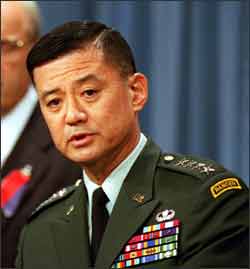
A Lighter, More Agile Force
Training excersises, Fort Lewis Washington (Photo: Joe Barrentine) Under a light rain and a cold wind, Captain Jerome Morrison is one player in the U.S. Army's effort to reinvent itself. Dressed in camouflaged fatigues, with mountain green and brown paint smeared across his cheeks, he directs a mortar team at the edge of a firing range at Fort Lewis, Washington, south of Seattle.
To the sounds of orders bellowed and explosions all around, Morrison is leading a routine practice, part of a plan to transform the Army from a heavy, cumbersome force that spent a half century preparing to fight a massive land battle in Europe against the Soviets, to a lighter force able to deploy quickly to fight the next war anywhere in the world.
Brigadier General John Brown is Deputy Commanding General for Transformation at Fort Lewis. He says that through the end of the Cold War, the U.S. focused on ground capability. The force was built up to confront "huge masses of armor on the plains of Europe and win a battle against a threat that had been identified and that we had trained against for decades."
MORE: "The Future of War,"by Fronline It's a different concept from today's Army he says. From conflicts in Bosnia, Kosovo, and Somalia, "we've come up with a concept now that gives us a full spectrum force," that will allow the U.S. to shape conflicts "rather than be more reactive."
Despite the success in Afghanistan, the U.S. Army is unsuited for its post-Cold War mission. Even the decisive Desert Storm victory against Iraq shows why. When Iraqi tanks thundered into Kuwait, the U.S. Army dispatched the lightly armed 82nd Airborne Division to the Desert, then spent six months building up its heavy armored forces before eventually routing the Iraqi army.
General Eric Shinseki (Photo: DoD) But Lt. Colonel Mike Negard at Fort Lewis says that slow, cumbersome build-up represented a huge risk. "It was by good luck and the grace of God that Saddam Hussein did not attack, because had he attacked with armor against a static, not well-protected, not mobile defense, we're not quite sure what that result would have been," he says.
Another case in point came in 1999. The Army tried to deploy its deadliest attack weapon, the Apache helicopter, to Albania to fight the Serbs. With too much heavy equipment and too little training, Task Force Hawk bogged down in the mud and proved futile. That same year, General Eric Shinseki was inducted as the Army's new chief and pledged to streamline the Army as it moves from the current "Legacy Force" to the so-called "Objective Force" of the future.
"Today our heavy forces are too heavy and our light forces lack the staying power we need," says Shinseki. "We will address those mismatches. Heavy forces must be more strategically deployable and more agile and with a smaller logistical footprint. Light forces must be more lethal, survivable, and more tactically mobile."
Light Armored Vehicle (Photo: Joe Barrentine) At Fort Lewis, soldiers are leading Shinseki's effort to build a force that combines the agility of light infantry with the punch of heavy armor. It's called the Interim Brigade Combat Team, or in a military that loves acronyms the "IBCT."
One of the keys to the IBCTs will be the light armored vehicle, or LAV, replacing much heavier 70 ton M-1 A-1 tanks. LAVs ride on wheels instead of treads, and are faster, easier to transport, and can go places tanks can't.
Captain John Kiriazis commands an exercise that involves unmanned reconnaissance. Aircraft fly overhead, as counterintelligence officers work alongside infantry soldiers from Charlie Company.
This raid is a standard military exercise, but the speed of the LAVs, the advantage of superior technology and intelligence, and the surgical use of force are supposed to make a difference.
Some of those participating in the exercises express sentiments of skepticism, but officers here say this is the biggest change to hit the Army since the helicopter.
Next: Hi-Tech Hits the Military's Training Ground
|
|


